with photos by Chris Manley, Tim Norriss, Pat Turner, Pete Eeles, Rob Turner and video by Lynn Fomison.
This report provides a summary of the butterflies and moths observed on a trip made to north-east Spain from 19th to 26th June 2010. The members of the party were Chris Manley, Lynn Fomison, Peter Davey, Peter Eeles, Robin and Pat Turner, and Tim Norriss.
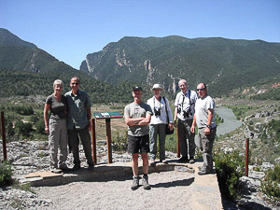 |
| Pat, Robin, Peter D, Lynn, Tim, Pete E Overlooking Reserva del Congost de Mont Rebei Image © Chris Manley |
The authors would like to thank a few individuals that have provided significant help in identifying some of the species mentioned in this report. They are Guy Padfield, Roger Gibbons and Bernard Watts. And many thanks to those members of UK Butterflies that also provided their input.
We were based at Casa Guilla in Santa Engracia, just north of the town of Tremp in Catalonia, north-east Spain, nestled in the foothills south of the Pyrenees.
 |
Each site we visited is identified with a letter (A through V) in this report, the details of which are:
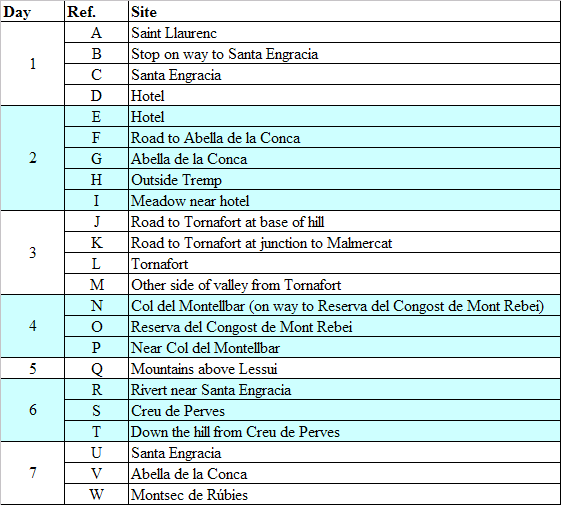 |
An early-morning start saw us arrive at Barcelona airport at 9:55am, allowing us to take in a couple of stops on our way to Santa Engracia where we were to be based. Our first stop was at Saint Llaurenc where we managed to find a dirt track leading into a small gorge.
.jpg) |
| Saint Llaurenc Image © Peter Eeles |
The area was surprisingly rich in butterflies, seeing 16 butterfly species in total. Familiar species included Brown Argus (Aricia agestis), Clouded Yellow (Colias crocea) including one of the form helice, Common Blue (Polyommatus icarus), Small Skipper (Thymelicus sylvestris), Small White (Pieris rapae), Speckled Wood (Pararge aegeria) of the nominate subspecies which is very brown, Swallowtail (Papilio machaon) and Wall Brown (Lasiommata megera). A surprise was finding a single Lulworth Skipper (Thymelicus acteon). We also saw several species not found in the British Isles, including a strong colony of False Ilex Hairstreak (Satyrium esculi). Relatively-familiar species to anyone who has visited the continent included Mallow Skipper (Carcharodus alceae), Marbled Skipper (Carcharodus lavatherae) and Scarce Swallowtail (Iphiclides podalirius). Less widespread species seen included a single Mediterranean Skipper (Gegenes nostrodamus), a single Osiris Blue (Cupido osiris) and several Spanish Gatekeeper (Pyronia bathseba), a species we were to encounter frequently on this trip. A Pale Shoulder moth was seen nectaring on mallow flowers, the larval foodplant.
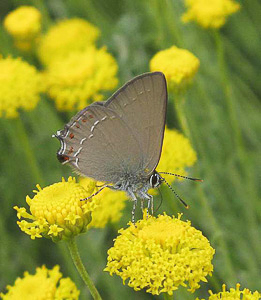 | .jpg) | .jpg) |
| False Ilex Hairstreak Image © Tim Norriss | Mallow Skipper Image © Peter Eeles | Marbled Skipper Image © Peter Eeles |
-9273-PT.jpg) | .jpg) | .jpg) |
| Scarce Swallowtail Image © Pat Turner | Mediterranean Skipper Image © Peter Eeles | Spanish Gatekeeper Image © Peter Eeles |
.jpg) | 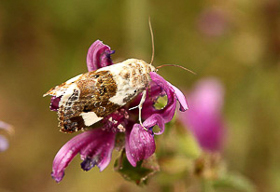 |
| Speckled Wood Image © Peter Eeles | Pale Shoulder Image © Chris Manley |
A little further on, we stopped again off the main road in an area that seemed to have been quarried to some small extent and that was rich in nectar sources. On exiting the cars we could already see several fritillaries flying about.
 | 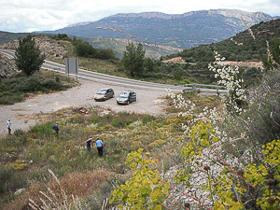 |
| Stop on way to Santa Engracia Image © Peter Eeles | Stop on way to Santa Engracia Image © Chris Manley |
Familiar species, but new to the trip, included Chalkhill Blue (Polyommatus coridon), Glanville Fritillary (Melitaea cinxia), Grizzled Skipper (Pyrgus malvae), Holly Blue (Celastrina argiolus), Large White (Pieris brassicae), Meadow Brown (Maniola jurtina), Silver-studded Blue (Plebejus argus) and Wood White (Leptidea sinapis). It was, again, strange and delightful to see several species considered "local" in the British Isles flying together at the side of a main road! False Ilex Hairstreak (Satyrium esculi) and Spanish Gatekeeper (Pyronia bathseba) were once again in good numbers. New species for the trip included Blue-spot Hairstreak (Satyrium spini), Dusky Heath (Coenonympha dorus), Escher's Blue (Polyommatus escheri), Iberian Marbled White (Melanargia lachesis), Knapweed Fritillary (Melitaea phoebe), Mazarine Blue (Cyaniris semiargus), Niobe Fritillary (Argynnis niobe), Red-underwing Skipper (Spialia sertorius), Southern White Admiral (Limenitis reducta) and Spotted Fritillary (Melitaea didyma). All in all, not bad for a "pit stop" at the side of the road!
-9110-PT.jpg) | -RT-2087.jpg) | .jpg) |
| Blue-spot Hairstreak Image © Pat Turner | Dusky Heath Image © Robin Turner | Escher's Blue Image © Peter Eeles |
.jpg) | .jpg) |  - RT-2606.jpg) |
| Iberian Marbled White Image © Peter Eeles | Knapweed Fritillary Image © Peter Eeles | Spotted Fritillary Image © Robin Turner |
Moths, too, were well represented. Goldwings were seen (there is only one British record from 1937) as well as Four-spotted and Straw Belle, both scarce in Britain. Eublemma pulchralis is similar to the Marbled Eublemma species seen as migrants at home.
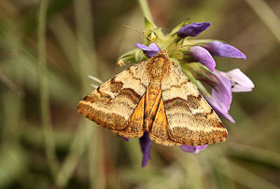 | 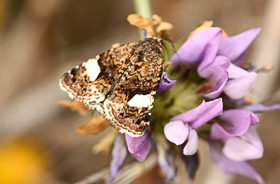 |
| Goldwing Image © Chris Manley | Four-spotted Image © Chris Manley |
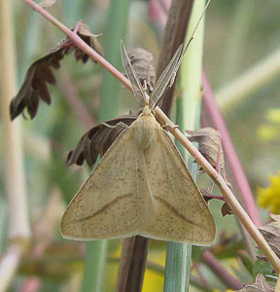 | 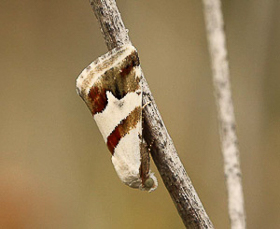 |
| Straw Belle Image © Tim Norriss | Eublemma pulchralis Image © Chris Manley |
As we approached Santa Engracia we decided to make one last stop, not really expecting to see anything particularly special other than a view over the nearby town of Tremp. The last remnants of water in a roadside ditch was teaming with tadpoles - we hoped they'd be able to make it through to adulthood before the sun got the better of their home. A single Dingy Skipper (Erynnis tages) was a new species for the trip. We also found a single Chapman's Blue (Polyommatus thersites) and, best of all, one of the Spanish specialties - a single female Spanish Fritillary (Euphydryas desfontainii) that looked as if it had seen better days. Several more Goldwing moths were flying, so obviously common around here.
.jpg) | 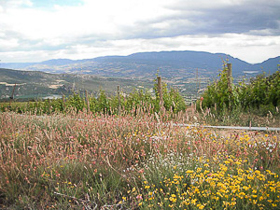 | .jpg) |
| View overlooking Tremp Image © Peter Eeles | Roadside above Tremp Image © Chris Manley | Spanish Fritillary Image © Peter Eeles |
Turning the corner we could see our final stop - Casa Guilla - perched on a rocky outcrop in the distance. Having settled into our rooms we all went out onto the balcony to take in the spectacular views of the surrounding countryside, when a single Painted Lady (Vanessa cardui) flew by, adding another species to our list and giving us a total of 38 butterfly species for the day - not bad given that we were simply making our way to Casa Guilla from the airport! We were then treated to a veritable feast by our hosts, something that we definitely looked forward to at the end of each day in the field.
.jpg) | 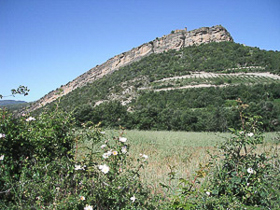 |
| Santa Engracia Image © Peter Eeles | Santa Engracia from Road Below Image © Chris Manley |
In this report, first sightings are shaded green in each table.
A - Saint Llaurenc
B - Stop on way to Santa Engracia
C - Santa Engracia
D - Hotel
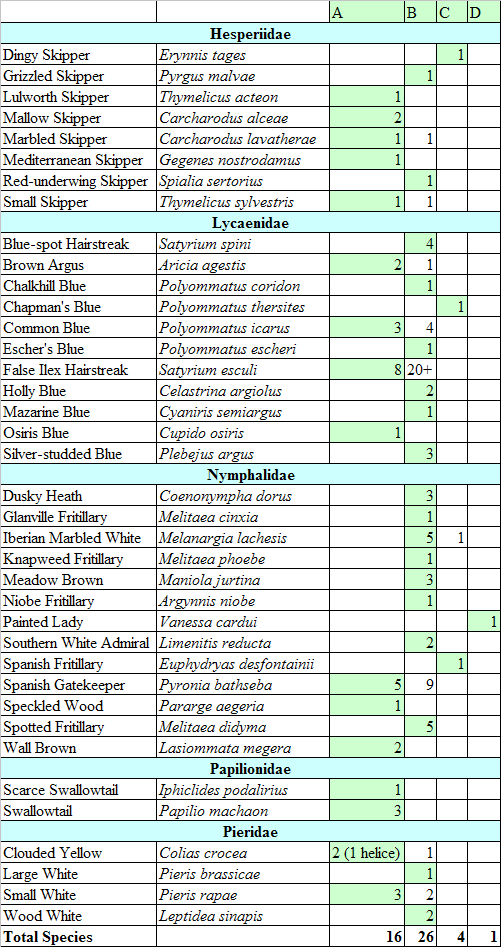 |
Moth traps run overnight produced 42 species, reflecting the rather cool conditions. Those on the British list included Jersey, Blotched and Essex Emeralds, Portland Ribbon Wave, Passenger, Alchymist and Latreille's Latin.
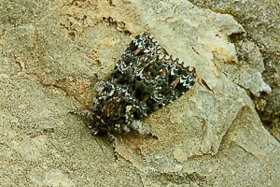 | 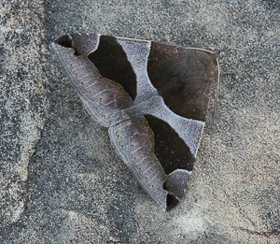 | 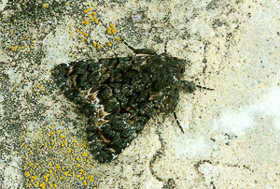 |
| Latreille's Latin Image © Chris Manley | Passenger Image © Tim Norriss | Alchymist Image © Chris Manley |
A quick wander around the immediate vicinity of the hotel threw up a surprise; a Large Wall Brown (Lasiommata maera) was sunning itself on the balcony and occasionally disturbing a Wall Brown (Lasiommata megera) that was also warming up in the morning sun, along with our first Small Tortoiseshell (Aglais urticae) for the trip. At the front of Casa Guilla a couple of Wall Brown (Lasiommata megera) were seen along with a good number of False Ilex Hairstreak (Satyrium esculi).
Today we decided to head to Abella de la Conca to the east of Tremp, a village nestled on a hillside, bounded by apparently sheer rockfaces popular with climbers.
.jpg) | .jpg) | 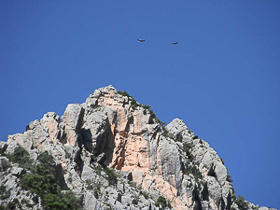 |
| Road to Abella de la Conca Image © Peter Eeles | Abella de la Conca Image © Peter Eeles | Griffon Vultures flying over Abella Image © Chris Manley |
We found a promising area next to the side of the road just before the village which turned up some new species for the trip - Black-veined White (Aporia crataegi), Heath Fritillary (Melitaea athalia), Provence Orange-tip (Anthocharis euphenoides) and Weaver's Fritillary (Boloria dia). There were also a couple of moths that are very scarce at home; Fiery Clearwing (a Red Data Book species) and Cynaeda dentalis. The yellow larval form of Spurge Hawk-moth was also found.
.jpg) | .jpg) |
| Black-veined White Image © Peter Eeles | Provence Orange-tip Image © Peter Eeles |
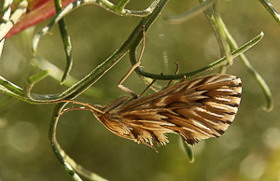 | 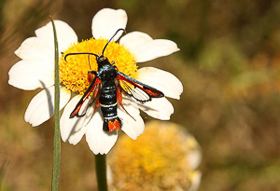 | 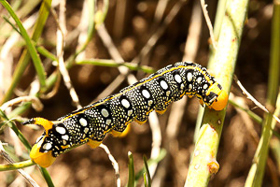 |
| Cynaeda dentalis Image © Chris Manley | Fiery Clearwing Image © Chris Manley | Spurge Hawk-moth larva (yellow form) Image © Chris Manley |
Just past the village the road came to an end, so we parked up and spent a few hours exploring the area. A small number of farms were surrounded by flower-rich meadows, with a very steep rocky hillside leading down into a gorge and a river below. All in all, the area provided a number of different habitats that offered up several new species for the trip.
.jpg) |
| Abella de la Conca Image © Peter Eeles |
Good numbers of Bath White (Pontia daplidice) were flying, along with a number of Berger's Clouded Yellow (Colias alfacariensis). A single Meadow Fritillary (Melitaea parthenoides) was found among a strong colony of Provence Chalkhill Blue (Polyommatus hispanus). We distinguished different species of Chalkhill Blue based primarily on the date and their condition (Chalkhill Blue were only just emerging, whereas Provence Chalkhill Blue were coming to the end of the flight season for the first brood). To top it off, a single Spanish Festoon (Zerynthia rumina) was also seen, probably the most exotic butterfly species found that day.
.jpg) |  - RT-3341.jpg) | -9328-PT.jpg) |
| Bath White Image © Peter Eeles | Meadow Fritillary Image © Robin Turner | Spanish Festoon Image © Pat Turner |
A Humming-bird Hawk-moth that seemed to be nectaring for rather a long time on a scabious turned out to have its proboscis trapped by a crab spider, Thomisus onustus. The spider won, surprisingly, and dined very well that day.
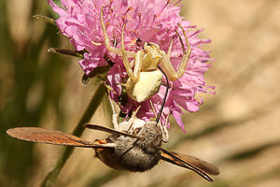 |
| Humming-bird Hawk-moth taken by Crab Spider Image © Chris Manley |
We decided to stop just outside Tremp on the way back to Casa Guilla, next to a railway line. We could see from the road that a piece of woodland had a very nice ride created through it, in order to ensure that the trees didn't encroach on telegraph and power lines.
.jpg) |
| Outside Tremp Image © Peter Eeles |
Good numbers of both Blue-spot Hairstreak (Satyrium spini) and False Ilex Hairstreak (Satyrium esculi) were found, along with a good number of Spotted Fritillary (Melitaea didyma) and Spanish Gatekeeper (Pyronia bathseba). A Wood White (Leptidea sinapis) was seen ovipositing and, in addition to the briefest of visits by a Swallowtail (Papilio machaon), we saw our first Cleopatra (Gonepteryx cleopatra) of the trip.
 - RT-3464.jpg) |
| Swallowtail Image © Robin Turner |
A Middle Lace Border led us a dance before settling inside a rather spiny shrub. A Lace Border seen later showed the distinguishing difference between the two, the lunules in the trailing corner of the hindwings being prominent in Lace Border but pale grey in Middle Lace Border.
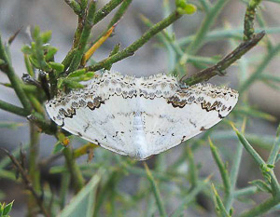 | 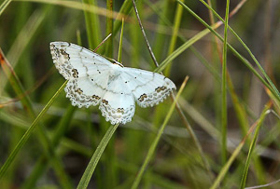 |
| Middle Lace Border Image © Tim Norriss | Lace Border Image © Chris Manley |
Stopping in a meadow near Santa Engracia on the way back to Casa Guilla, we found a good number of Clouded Yellow, including a mating pair, rounding the day off nicely.
.jpg) |
| Clouded Yellow Image © Peter Eeles |
E - Hotel
F - Road to Abella de la Conca
G - Abella de la Conca
H - Outside Tremp
I - Meadow near hotel
 |
The moth traps overnight had a total of just seven moths! This was almost certainly due to the fresh snow visible on the hill tops to the north and the wind from them making it extremely cold at dawn! Three of the moths were Oak Hawks (Marumba quercus).
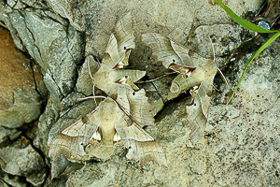 | 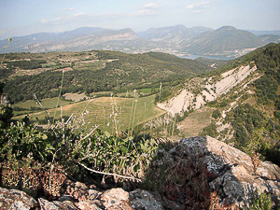 |
| Oak Hawk-moths Image © Chris Manley | View east from moth trap site at Casa Guilla Image © Chris Manley |
Today we decided to pay a visit to Tornafort, near Sort, north of Tremp. We stopped shortly after leaving the main road, stopping in a small layby. The change of scenery immediately paid dividends with our first sightings of Esper's Marbled White (Melanargia russiae), Nettle-tree Butterfly (Libythea celtis), Pale Clouded Yellow (Colias hyale) and Red Admiral (Vanessa atalanta). Southern White Admiral (Limenitis reducta) were also present in good numbers, gliding up and down the tree-lined road. We ploughed on and eventually reached a junction with roads leading to Tornafort and Malmercat. We decided to stop here since some of the surrounding fields looked very promising with nectar sources bursting into life all around us.
.jpg) | 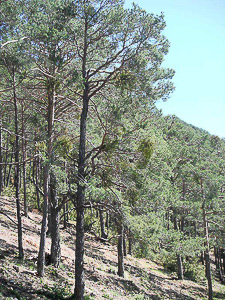 |
| Road to Tornafort at junction to Malmercat Image © Peter Eeles | Mistletoe on Scots Pine Image © Chris Manley |
As it happens, we managed to turn up 35 species for that area with 8 new species for the trip; Adonis Blue (Polyommatus bellargus) which were in good numbers, Amanda's Blue (Polyommatus amandus), Chequered Blue (Scolitantides orion), Green-underside Blue (Glaucopsyche alexis), Marbled Fritillary (Brenthis daphne), Pearly Heath (Coenonympha arcania), Queen of Spain Fritillary (Issoria lathonia) and Sloe Hairstreak (Satyrium acaciae). Provence Orange-tip (Anthocharis euphenoides) were frequently seen, behaving much like our own Orange-tip, with a relatively-weak flight and males investigating every flower head of their larval foodplant in search of a mate.
-2.jpg) | .jpg) | -6-PT.jpg) |
| Adonis Blue (female) Image © Peter Eeles | Chequered Blue (female) Image © Peter Eeles | Chequered Blue (female) Image © Pat Turner |
.jpg) | .jpg) | .jpg) |
| Amanda's Blue (male) Image © Peter Eeles | Amanda's Blue (female) Image © Peter Eeles | Amanda's Blue (underside) Image © Peter Eeles |
.jpg) | .jpg) | -RT-2657.jpg) |
| Marbled Fritillary Image © Peter Eeles | Marbled Fritillary Image © Peter Eeles | Pearly Heath Image © Robin Turner |
We carried on to Tornafort, finding 9 new species for the trip as a result; Comma (Polygonia c-album), Essex Skipper (Thymelicus lineola), False Heath Fritillary (Melitaea diamina), Grayling (Hipparchia semele), Green Hairstreak (Callophrys rubi), Long-tailed Blue (Lampides boeticus), Piedmont Ringlet (Erebia meolans), Safflower Skipper (Pyrgus carthami) and Small Blue (Cupido minimus). Moths seen included Anania funebris, Pyrausta sanguinalis, Eurrhypis pollinalis, Black-veined and Beautiful Marbled. Also a stunning blue beetle and a pair of quail.
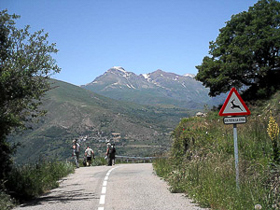 | .jpg) |
| View from Tornafort Image © Chris Manley | False Heath Fritillary Image © Peter Eeles |
.jpg) | .jpg) |
| Piedmont Ringlet Image © Peter Eeles | Safflower Skipper Image © Peter Eeles |
To round off the day we decided to drive back to the main road and then up the other side of the valley toward Enviny. We were, once again, astounded by the sheer variety of species found in such a small area. We also managed to notch up another 2 new species for the trip, Dark Green Fritillary (Argynnis aglaja) and Small Heath (Coenonympha pamphilus), as well as a new burnet moth, before heading back to Casa Guilla for another sumptuous meal!
.jpg) | 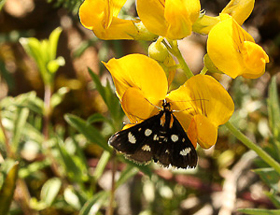 | 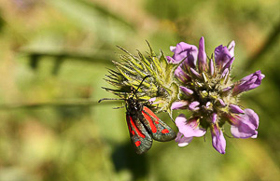 |
| Other side of valley from Tornafort Image © Peter Eeles | Anania funebris Image © Chris Manley | Zygaena romeo Image © Chris Manley |
J - Road to Tornafort at base of hill
K - Road to Tornafort at junction to Malmercat
L - Tornafort
M - Other side of valley from Tornafort
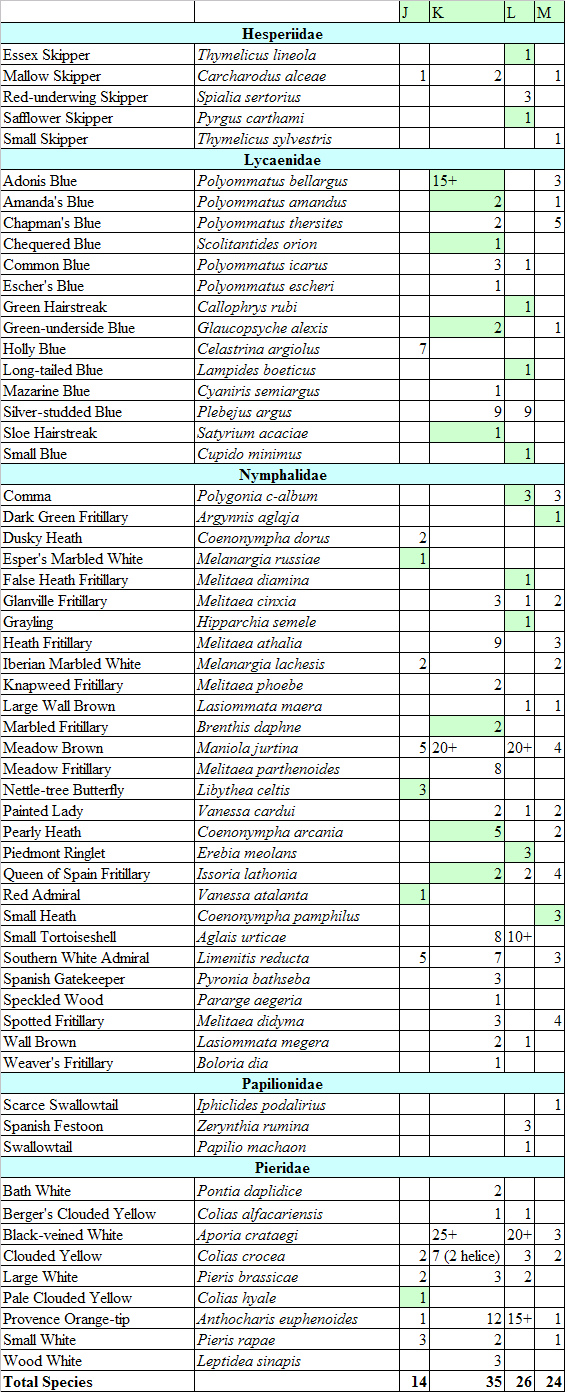 |
Milder conditions overnight produced a better catch of moths with 54 species, including Olive Beauty, Antirrhinum Brocade, Portland Ribbon Wave, Dark Umber, Scarce Blackneck and Spurge Hawk. Also Zethes insularis, looking very like a Passenger, and the extraordinary-looking Eutelia adulatrix.
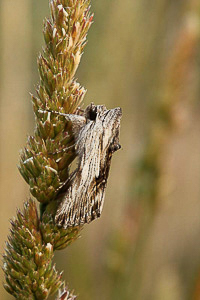 | 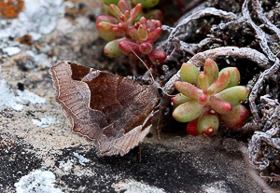 | 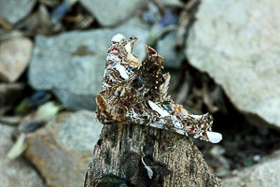 |
| Antirrhinum Brocade Image © Chris Manley | Zethes insularis Image © Chris Manley | Eutelia adulatrix Image © Chris Manley |
Today we decided to head south-west, to Reserva del Congost de Mont Rebei, a rather spectacular gorge that had been cut into the mountainside by the river that runs through it. Turning that last corner to see the gorge open up is really quite difficult to describe, but was quite spectacular with a great river plane stretching into the distance. We quickly made our way onto the reserve which, surprisingly (given its size) only had a few visitors' cars in the car park - one advantage of visiting while children are still at school!
.jpg) | 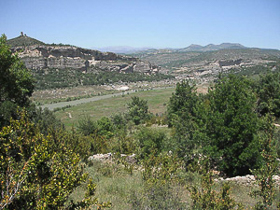 |
| Reserva del Congost de Mont Rebei Image © Peter Eeles | Reserva del Congost de Mont Rebei Image © Chris Manley |
A damp clearing next to the car park contained a small colony of Twin-spot Fritillary (Brenthis hecate), flying alongside numerous Wood White (Leptidea sinapis). A single Purple Hairstreak (Favonius quercus) was also seen along with several Great Banded Grayling (Brintesia circe) that looked absolutely huge when compared with the other species flying. Other firsts for the trip included Green-veined White (Pieris napi), Large Skipper (Ochlodes sylvanus), Marbled White (Melanargia galathea), Northern Wall Brown (Lasiommata petropolitana), Rosy Grizzled Skipper (Pyrgus onopordi) and our third Marbled White species for the trip, Western Marbled White (Melanargia occitanica). The variety of habitats available and the sheer variety and number of butterflies kept our interest and the 4 or 5 hours spent here seemed to fly by. We left the reserve having seen 43 butterfly species in total, as well as 8 moths including Oncocera semirubella and Feathered Footman.
.jpg) |  - RT-3552.jpg) | .jpg) |
| Twin-spot Fritillary Image © Peter Eeles | Rosy Grizzled Skipper Image © Robin Turner | Western Marbled White Image © Peter Eeles |
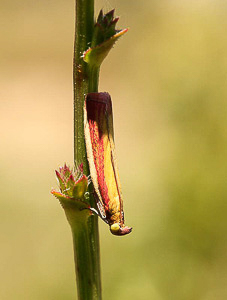 | 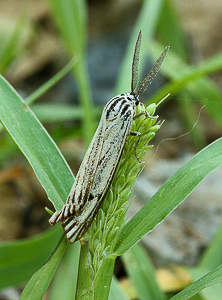 |
| Oncocera semirubella Image © Chris Manley | Feathered Footman Image © Chris Manley |
Heading back to Case Guilla, we stopped near the top of Col del Montellbar to see what was around - stopping at the side of the road nearly always seemed to reveal something interesting! Although we found no new species, there were good numbers of very fresh Twin-spot Fritillary (Brenthis hecate) and good numbers of Provence Chalkhill Blue (Polyommatus hispanus) too. We were also joined by several species that had become very familiar during the trip; they seemed to be at most sites. This included Berger's Clouded Yellow (Colias alfacariensis), Black-veined White (Aporia crataegi), Chapman's Blue (Polyommatus thersites), Iberian Marbled White (Melanargia lachesis), Meadow Brown (Maniola jurtina), Osiris Blue (Cupido osiris), Pearly Heath (Coenonympha arcania), Silver-studded Blue (Plebejus argus), Spanish Gatekeeper (Pyronia bathseba) and Spotted Fritillary (Melitaea didyma).
.jpg) | 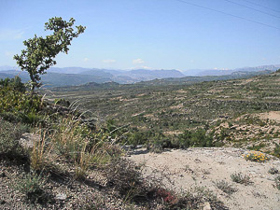 |
| Near Col del Montellbar Image © Peter Eeles | Near Col del Montellbar Image © Chris Manley |
N - Col del Montellbar (on way to Reserva del Congost de Mont Rebei)
O - Reserva del Congost de Mont Rebei
P - Near Col del Montellbar
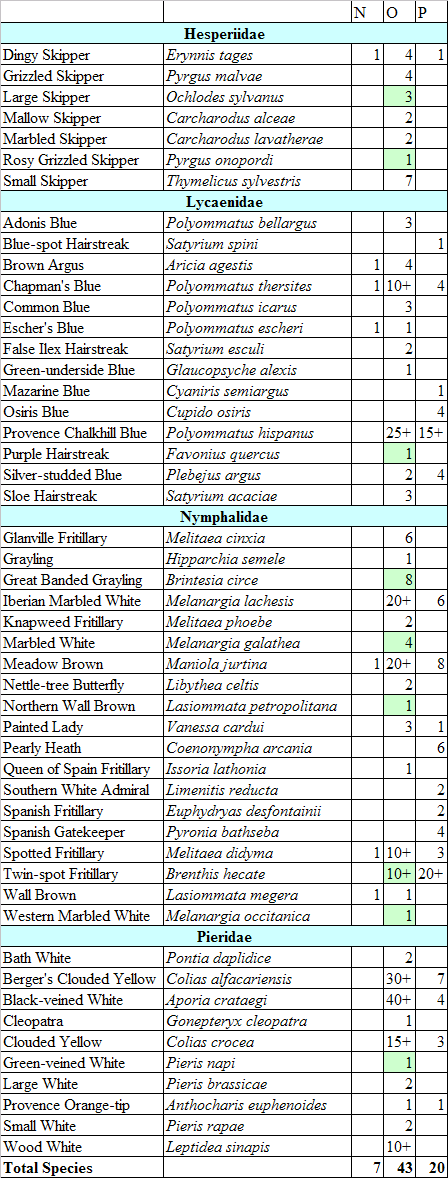 |
The moth traps overnight produced some 60 species, including Oak Yellow Underwing, Purple Marbled, Dorset Cream Wave, Ancylis cinnamomella and Feathered Beauty.
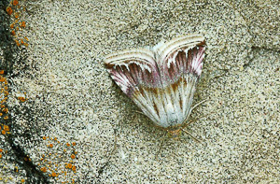 | 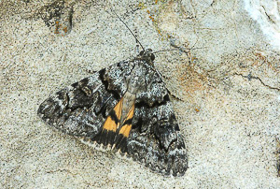 | 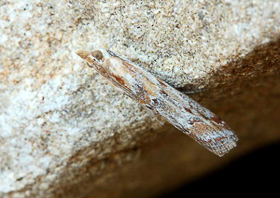 |
| Purple Marbled Image © Chris Manley | Oak Yellow Underwing Image © Chris Manley | Ancylosis cinnamomella Image © Chris Manley |
Today we decided to get high into the mountains, and settled on those above Lessui in the foothills of the Pyrenees. Slowly, but surely, we made our way up the winding roads, stopping to give way to an incredible number of blues that were mud-puddling on a trickle of water that was coming off the mountain and running across the road. Identifying all of the species was an impossible task but photographic evidence, once back home, gave the "mud puddling blues" as Adonis Blue (Polyommatus bellargus), Chapman's Blue (Polyommatus thersites), Chequered Blue (Scolitantides orion), Common Blue (Polyommatus icarus), Escher's Blue (Polyommatus escheri), Geranium Argus (Aricia eumedon) (new for the trip), Green-underside Blue (Glaucopsyche alexis), Mazarine Blue (Cyaniris semiargus), Mother-of-pearl Blue (Polyommatus nivescens) (new for the trip), Osiris Blue (Cupido osiris), Silver-studded Blue (Plebejus argus), Small Blue (Cupido minimus) and Turquoise Blue (Polyommatus dorylas) (new for the trip). That's 13 species in total! Given that these were also joined by various fritillaries and skippers, it was no wonder we felt a little overwhelmed. Thank goodness for our digital record!
.jpg) | .jpg) | .jpg) |
| Mud-puddling Blues Image © Peter Eeles | Mud-puddling Blues Image © Peter Eeles | Mud-puddling Blues Image © Peter Eeles |
-3.jpg) | -9667-PT.jpg) |
| Turquoise Blue Image © Peter Eeles | Turquoise Blue Image © Pat Turner |
In addition to a few of the blues, other new species for the trip were familiar to us - Brimstone (Gonepteryx rhamni), Orange-tip (Anthocharis cardamines) and Pearl-bordered Fritillary (Boloria euphrosyne). We also saw our first Camberwell Beauty (Nymphalis antiopa), Provental Fritillary (Melitaea deione) and Sooty Copper (Lycaena tityrus). Being so high up we also found what we were hoping for - some Erebia. A single Piedmont Ringlet (Erebia meolans) was accompanied by a good number of de Prunner's Ringlet (Erebia triaria), whose dark wings really stood out among the other butterflies.
.jpg) | .jpg) |
| de Prunner's Ringlet Image © Peter Eeles | de Prunner's Ringlet Image © Peter Eeles |
Driving further up the mountain we could see the snow-covered peaks. We eventually reached some abandoned ski lifts and could only imagine what the mountain must look like when totally covered in snow. With few nectar sources, we didn't see that many butterflies. However, we did end the day with a total of 50 species so couldn't complain!
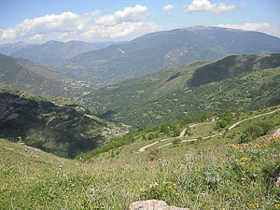 | .jpg) |
| Track leading up from Lessui Image © Chris Manley | Mountains above Lessui Image © Peter Eeles |
.jpg) | 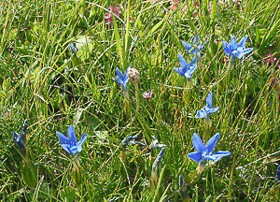 |
| Mountains above Lessui Image © Peter Eeles | Gentians above Lessui Image © Chris Manley |
Q - Mountains above Lessui
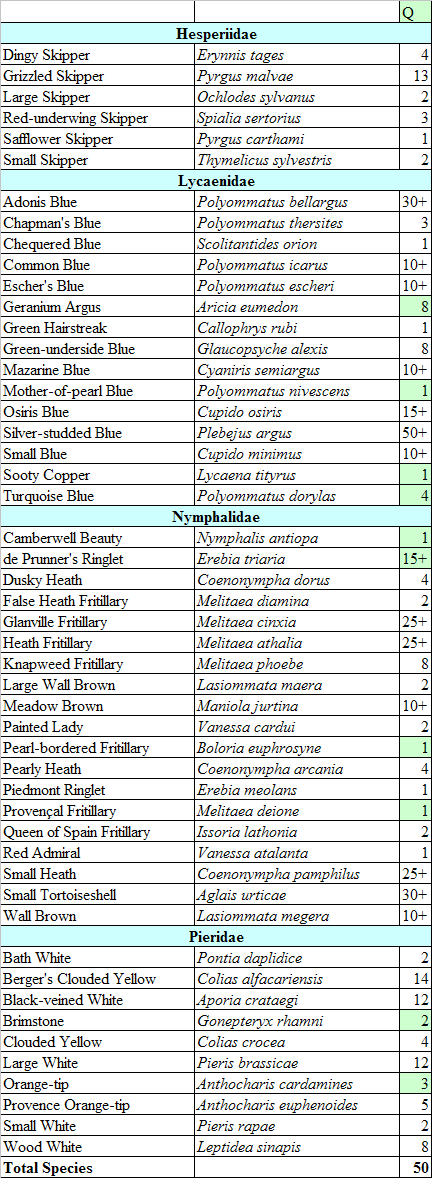 |
There were 76 species of moths this morning including Bright Wave, Spotted Sulphur, Clancy's Rustic, Latreille's Latin and Pine Tree Lappet.
 | 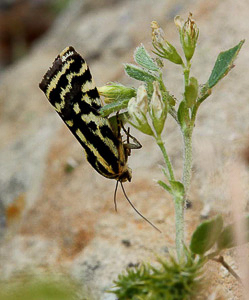 | 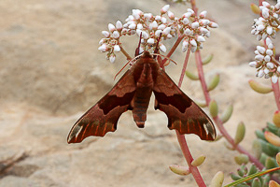 |
| Pine Tree Lappet Image © Chris Manley | Spotted Sulphur Image © Chris Manley | Lime Hawk-moth aberration Image © Chris Manley |
Today we decided to head off to Creu de Perves, first taking in the village of Rivert, not far from Santa Engracia. Given the relatively-small area we covered, we were surpsied to come away with a tally of 33 species in a little over an hour.
.jpg) | .jpg) |
| Rivert near Santa Engracia Image © Peter Eeles | Rivert near Santa Engracia Image © Peter Eeles |
The first surprise was finding a Large Tortoiseshell (Nymphalis polychloros) settled on some riverside plants, predictably flying up into the air as it was approached, never to be seen again! We also got our first sightings of Spanish Purple Hairstreak (Laeosopis roboris) which, while similar to our own Purple Hairstreak, is noticeably different when seen close up. Other firsts for the trip included Silver-washed Fritillary (Argynnis paphia) and Small Copper (Lycaena phlaeas). Cynaeda dentalis was spotted, as well as Humming-bird Hawk, Feathered Footman, Straw Belle and Chimney Sweeper.
.jpg) | -0062-PT.jpg) |  |
| Spanish Purple Hairstreak Image © Peter Eeles | Spanish Purple Hairstreak Image © Pat Turner | Cynaeda dentalis Image © Chris Manley |
We then headed on to Creu de Perves, a village perched on a mountainside. We drove past the village and ultimately parked up in a fairly open area where most of the surrounding area was accessible. The village is at an elevation of 1334 metres (for the record, Britain's highest peak is Ben Nevis at 1344 metres).
.jpg) | 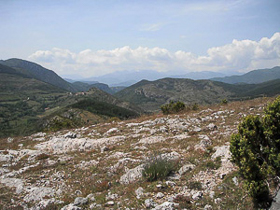 |
| Creu de Perves Image © Peter Eeles | Creu de Perves Image © Chris Manley |
The numerous Black-veined White (Aporia crataegi) were flying all around and it wasn't long before we found another new species for the trip, a number of newly-emerged Spanish form of Chestnut Heath (Coenonympha glycerion). A single Oberthnr's Grizzled Skipper (Pyrgus armoricanus) was also found. Glanville Fritillary (Melitaea cinxia), Heath Fritillary (Melitaea athalia) and Meadow Fritillary (Melitaea parthenoides) were flying together in good numbers, testing our identification skills. To round off our visit, we found a final instar Swallowtail (Papilio machaon) larva feeding on Fennel. Stopping a little way down the hill we saw a couple of Camberwell Beauty (Nymphalis antiopa) before heading back to Casa Guilla.
.jpg) | .jpg) |
| Chestnut Heath Image © Peter Eeles | Swallowtail larva Image © Peter Eeles |
Day-flying moths included the stunning Pyrausta sanguinalis (now confined to the Isle of Man in Britain), Common Heath, Merrifielda leucodactyla as well as a large puffball looking totally out of place on the hot, dry, rocky slope.
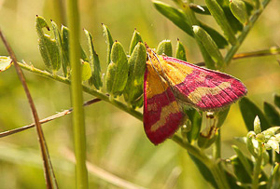 | 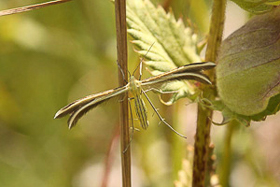 | 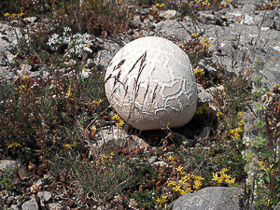 |
| Pyrausta sanguinalis Image © Chris Manley | Merrifielda leucodactyla Image © Chris Manley | Puffball Image © Chris Manley |
One item that should be mentioned, that isn't at all Lepidoptera-related, is the spectacular scenery we were treated to on our travels. Rivers, lakes and mountains seemed to follow us wherever we went, which made for a more-enjoyable car journey.
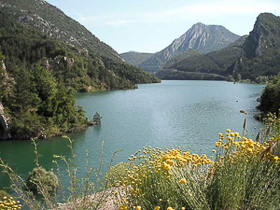 |
| Catalonia Image © Chris Manley |
R - Rivert near Santa Engracia
S - Creu de Perves
T - Down the hill from Creu de Perves
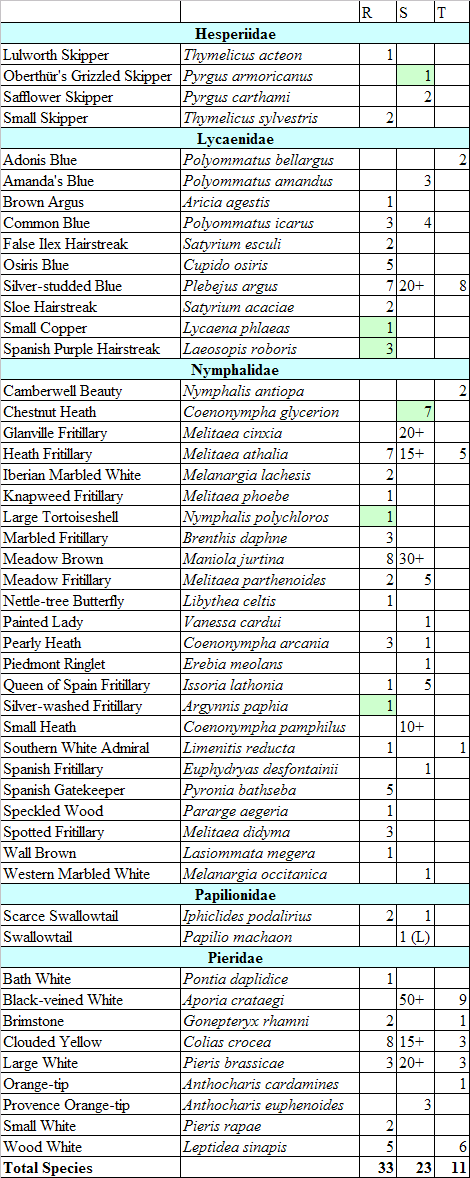 |
A good start to the day with 71 moth species were found in the traps this morning.
Knowing what to do on the last day of a trip is always a challenge. We'd always indended to head north, deep into the Pyrenees, but none of us really wanted to spend the best part of 5 hours travelling. We compromised and decided to spend the day back at Abella de la Conca which we felt held more secrets for us. The first order of the day, however, was to get up early to find Spanish Gatekeeper (Pyronia bathseba) that were just warming up and holding their wings open for more than a nanosecond! An early morning walk found them waking up around 7:30am and, as hoped for, were sunning themselves on patches of bare earth and obliging the cameras. "Little black jobs" were also flitting about - clearly hairsreaks of some sort. Closer inspection revealed gave us our first sightings of Ilex Hairstreak (Satyrium ilicis) for the trip - and just a walk down the road from Casa Guilla!
-9135-PT.jpg) |
| Ilex Hairstreak Image © Pat Turner |
It wasn't long before we arrived back at Abella de la Conca and already knowing the site definitely gave us an advantage. First stop - down in the gorge - which provided a great deal of shelter! Being here earlier in the day than our previous visit paid off with sightings of several new species for the trip - Marsh Fritillary (Euphydryas aurinia), which was difficult to tell apart from Spanish Fritillary (Euphydryas desfontainii), Mountain Dappled White (Euchloe simplonia), Mountain Small White (Pieris ergane), Panoptes Blue (Pseudophilotes panoptes) and a couple of very fresh male Purple-shot Copper (Lycaena alciphron) that were flying in a field next to a disused farmhouse down in the gorge and where some of the locals were swimming in the waters flowing down from the surrounding hills and into the gorge. Even our first Peacock (Aglais io) put in a showing. Butterflies were, literally, everywhere, and we spent a good few hours just taking it all in. Just as we were getting ready to leave, a single and very fresh male High Brown Fritillary (Argynnis adippe) turned up, nectaring on a large Thistle, bringing our total for the site to a very respectable 55.
.jpg) | .jpg) |
| Mountain Dappled White Image © Peter Eeles | Mountain Small White Image © Peter Eeles |
.jpg) | .jpg) |
| Purple-shot Copper Image © Peter Eeles | Purple-shot Copper Image © Peter Eeles |
We decided to stop at a river valley at Montsec de R˙bies on the way back. Unfortunately, the scorching sun had completely baked the site which was not only unbearably hot, but unable to host many butterflies.
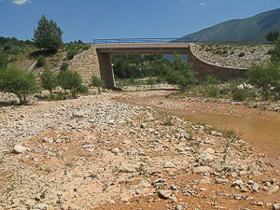 |
| Montsec de R˙bies Image © Tim Norriss |
However, we did see our first Duke of Burgundy (Hamearis lucina) and Meleager's Blue (Polyommatus daphnis, with its distinctive scalloped hindwing) for the trip and were entertained by a Great Banded Grayling (Brintesia circe) that was flying around one of the cars, as well as good colonies of Spotted Fritillary (Melitaea didyma), Nettle-tree Butterfly (Libythea celtis) and False Ilex Hairstreak (Satyrium esculi). There were a few moths flying such as Feathered Footman, Goldwing and Aglaope infausta (which is very local in north east Spain) in blackthorn thickets, and Alvaradoia numerica. 64 butterfly species on the last day of our trip (giving a grand total of 109 species) was the perfect ending to our trip to this wonderful part of the world.
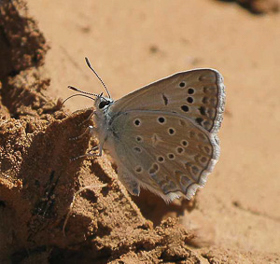 | 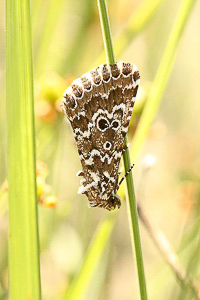 |
| Meleager's Blue Image © Tim Norriss | Alvaradoia numerica Image © Chris Manley |
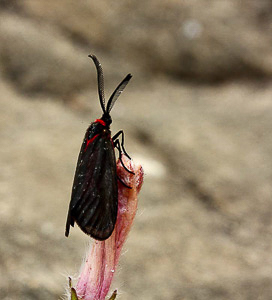 | 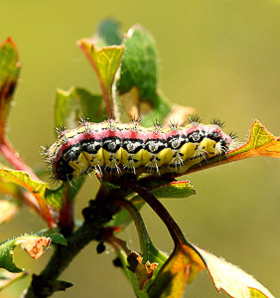 |
| Aglaope infausta Image © Chris Manley | Aglaope infausta larva Image © Chris Manley |
We stopped at the small meadow below Santa Engracia where we spotted 8 species of moth flying, including Lace Border, Feathered Footman, Straw Belle, Humming-bird Hawk, Chrysocrambus craterella and Oncocera semirubella. This gave a total of 188 moth species for the trip, of which 127 are on the British list.
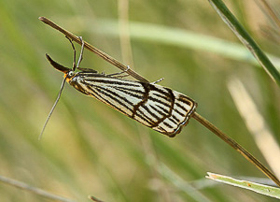 |
| Chrysocrambus craterella Image © Chris Manley |
U - Santa Engracia
V - Abella de la Conca
W - Montsec de R˙bies
 |
 |